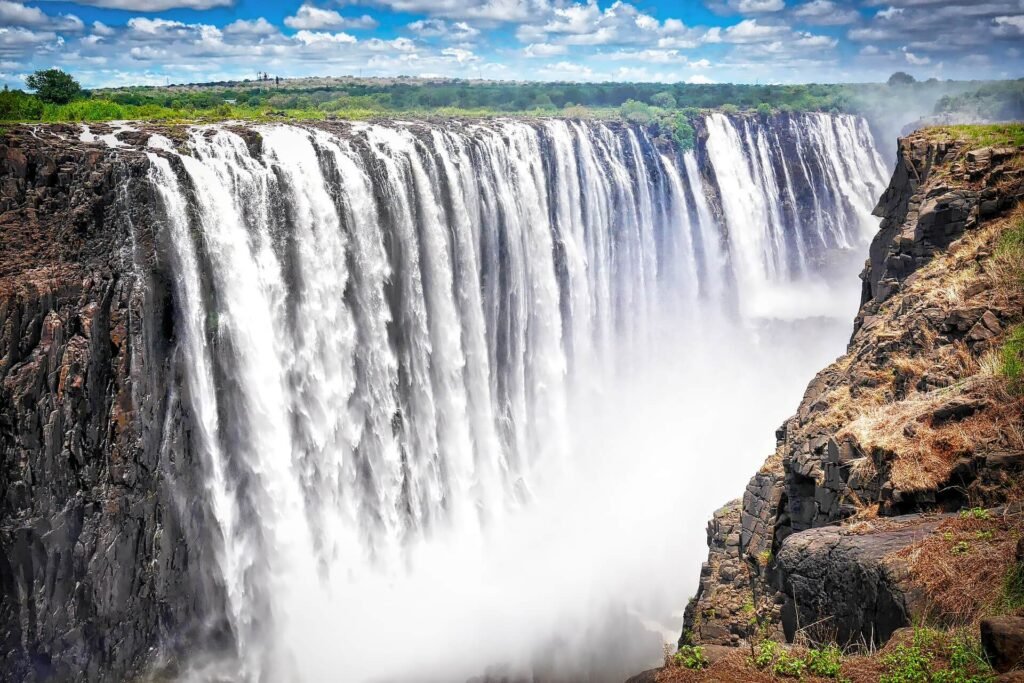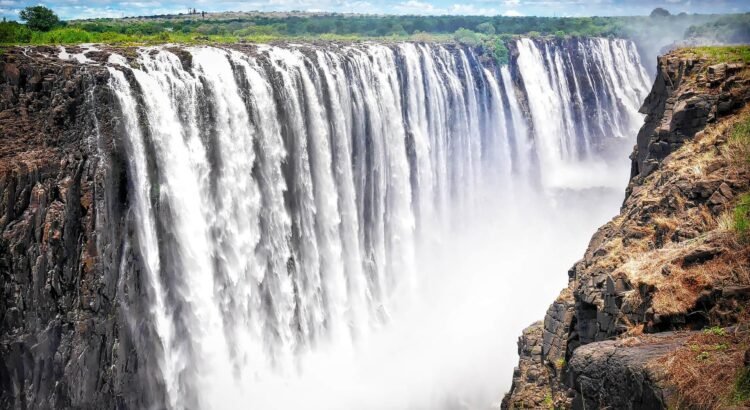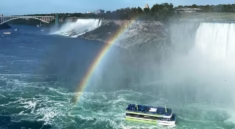
Few natural wonders on Earth evoke such awe and exhilaration as Victoria Falls—a colossal curtain of water where the mighty Zambezi River plunges into a deep chasm at the border of Zambia and Zimbabwe. Known locally as Mosi-oa-Tunya, meaning “The Smoke That Thunders”, this spectacle of raw power, noise, mist, and light is the largest waterfall in the world when measured by combined height and width.
Standing before Victoria Falls, you are instantly humbled by its scale, sound, and sheer force. With a width of 1,708 meters (5,604 feet) and a height of 108 meters (354 feet), it forms the largest single sheet of falling water on Earth—so grand that its spray can be seen from over 40 kilometers away during peak flow.
Whether you choose to experience it from the verdant rainforests on the Zimbabwean side, the thrilling edge of Devil’s Pool on the Zambian side, or the air above in a helicopter flight, Victoria Falls is a journey into nature’s most spectacular drama—a world of power, beauty, and legend.
A Natural Wonder Beyond Comparison
Victoria Falls is one of the Seven Natural Wonders of the World and a UNESCO World Heritage Site, recognized not only for its size and visual impact but also for its ecological richness and cultural significance. It’s the kind of place that etches itself into memory—roaring water, swirling mists, brilliant rainbows, and the visceral experience of standing on the edge of nature’s fury.
Its geological formation is equally fascinating. The falls are formed as the Zambezi River flows over a basalt plateau, where fault lines and fissures have shaped a series of gorges. Over thousands of years, the river has carved new channels, creating successive waterfalls. What we see today is just one phase in this continuous geological evolution.
Mosi-oa-Tunya: The Smoke That Thunders
Long before British explorer David Livingstone became the first European to see the falls in 1855 and named them after Queen Victoria, local tribes had revered this place. The Kololo people gave it the name Mosi-oa-Tunya, a title that captures both its auditory and visual grandeur. Even from miles away, the rising mist looks like smoke, and the thunderous sound can shake the earth beneath your feet.
To this day, the falls hold spiritual and cultural importance for many communities along the Zambezi. Traditional ceremonies, stories, and taboos are still associated with the river and the falls, making this not only a natural landmark but a sacred space.
Two Countries, Two Perspectives
Victoria Falls straddles the international border between Zambia and Zimbabwe, and each side offers distinct yet complementary experiences:
Zimbabwean Side: The Classic Panoramic View
On the Zimbabwean side lies Victoria Falls National Park, where a network of rainforest trails leads you to 16 viewing points across nearly two-thirds of the falls. This side offers the most comprehensive view of the falls—especially Main Falls, Horseshoe Falls, Rainbow Falls, and Devil’s Cataract.
Highlights include:
- The Rainforest Walk: Due to the constant spray, a unique rainforest ecosystem thrives here, complete with ferns, palms, orchids, and mosses—lush greenery in the middle of dry savannah.
- Livingstone Statue: Near one viewpoint stands a statue of David Livingstone, who famously remarked, “Scenes so lovely must have been gazed upon by angels in their flight.”
- Rainbows Galore: The high volume of mist means that rainbows—sometimes even moonbows during full moon nights—are a frequent and breathtaking sight.
Zambian Side: Up Close and Personal
Across the river, Mosi-oa-Tunya National Park in Zambia provides a more intimate and adventurous experience. Here, you can literally walk to the edge of the abyss, where the water plummets into the gorge.
Key experiences include:
- Knife-Edge Bridge: A narrow walkway suspended above the gorge offers one of the most thrilling and drenching experiences—you are so close that the roar of the falls is deafening.
- Devil’s Pool: In the dry season (August to December), brave visitors can swim at the edge of the falls in a naturally formed rock pool just inches from the drop.
- Boiling Pot Hike: This trail descends into the canyon to the swirling whirlpools below—an exhilarating way to experience the falls from ground level.
When to Visit: Seasons of the Falls
Victoria Falls offers a different face each season, giving travelers reasons to return:
- High Water (February–May): The falls are at their most powerful, thundering with force. While visibility can be reduced due to heavy spray, the experience is overwhelming and raw.
- Low Water (August–December): Sections of the falls may dry out, especially on the Zambian side, but this allows for unique activities like Devil’s Pool and better views of the rock formations.
- Shoulder Seasons (June–July, January): Balanced conditions with good water flow and accessibility to most activities.
Activities Beyond the Falls
The surrounding region is a playground of adventure, culture, and wildlife, offering something for every kind of traveler:
1. Helicopter and Microlight Flights
For a bird’s eye view, nothing beats an aerial tour. Helicopter rides offer a full panorama of the falls, Zambezi River, and gorges. Microlight flights, available in Zambia, provide an even more exhilarating, open-air experience.
2. White Water Rafting
The Zambezi River below the falls is one of the best white-water rafting destinations in the world, with Class IV and V rapids such as “Oblivion,” “Stairway to Heaven,” and “The Devil’s Toilet Bowl.”
3. Sunset Cruises
Above the falls, the Zambezi River flows gently, making it perfect for sunset cruises with drinks, snacks, and sightings of hippos, crocodiles, and elephants along the riverbanks.
4. Wildlife Safaris
Both Zambia and Zimbabwe offer rich wildlife experiences nearby. You can take game drives in Zambezi National Park or walk with rhinos in Mosi-oa-Tunya National Park, which, though small, is home to zebras, giraffes, and white rhinos.
5. Cultural Encounters
Local villages and cultural centers offer insights into the traditions, crafts, music, and dances of the Tonga and Lozi people. Don’t miss the chance to visit a local market or watch a traditional drumming performance.
Sustainable Tourism and Community Impact
Victoria Falls is more than a tourist destination—it is a source of livelihood for local communities. Efforts in conservation, anti-poaching, and ecotourism are vital in protecting the falls and the surrounding ecosystems.
Visitors are encouraged to support locally-owned lodges, guides, and craft markets to ensure that tourism benefits the people who live here. Many conservation projects, including wildlife rehabilitation and reforestation, welcome volunteers and donations.
Tips for Visitors
- Entry Visas: Both Zambia and Zimbabwe require visas, but a KAZA Univisa allows multiple entries between the two countries and day trips to Botswana.
- Currency: In Zimbabwe, the US dollar is widely accepted. In Zambia, the local currency is the Zambian kwacha.
- Packing Essentials: Raincoats or ponchos (for the spray), waterproof bags, sturdy shoes, and sun protection.
- Health: Malaria prophylaxis is recommended. Drink only bottled or purified water.
A Moment That Stays With You
Standing before Victoria Falls is more than sightseeing—it’s an emotional encounter with the elemental forces of the Earth. The thunder of falling water, the feel of mist on your face, and the endless cascade disappearing into rainbows and gorges—it fills your senses and spirit with wonder.
Some places remind you how small we are in the grand design of nature. Victoria Falls is one of them.
Whether you come for adventure, photography, culture, or tranquility, this majestic waterfall delivers. And as the Zambezi continues its eternal plunge, so too does Victoria Falls continue to captivate, inspire, and roar with life.




